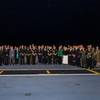Feature: It's About Time and Money Willamette Star "Stretch"
By Larry Pearson
About a year ago Dan Yates, president of American Waterways, Inc., (dba Portland Spirit) of Portland, Oregon had a pleasant, yet vexing problem. His fleet of three dinner cruise vessels was doing good business, but he needed a vessel that could seat 100-140 passengers for a meal function. His fleet included the Crystal Dolphin that held 50 people for dinner, the Willamette Star with a 70 person seated capacity and the 350 passenger (540 for cocktails) Portland Spirit.
"We were turning away business that was ideal for a 100-150 passenger vessel. Our Crystal Dolphin was too small and the Portland Spirit too large," Yates reported.
"To capture this business our decision came down to buying a new vessel that would seat 100 plus for dinner or rebuilding and lengthening the Willamette Star, an 80-ft., 1996 vintage Skipperliner vessel" Yates said.
There were other considerations as well. Yates could give up the vessel for an eight-week period only, about the middle of January to the middle of March.
The economics of the decision were that a new boat with the extra passenger capacity would cost about $1.9 million delivered. The Willamette Star was worth about $850,000 in trade reducing the cash outlay for a new boat to about $1 million. Yates had to figure out that if rebuilding the Willamette Star could be done for under $1 million and done in the eight-week time frame it would make sense to take that approach.
To start that process, Yates called on the naval architecture firm of DeJong & Lebet, Jacksonville, Fla. Andy Lebet, vice president of the firm, flew out to Portland to survey the vessel. "Lebet actually had to reverse engineer the vessel," Yates said. "We had no drawings on the boat, so Lebet created drawings to assist in the feasibility process," Yates added.
"There was little doubt that the vessel could be lengthened to give the owner the additional meal seating he desired, plus add additional features to the boat and work well within his budget," Lebet added.
"The decision where to cut the vessel had a lot to do with aesthetics as well as engineering considerations," Yates said. "I wanted a boat that did not look like it had major surgery. I wanted the midbody to blend in perfectly with the rest of the boat with a continuum of the windows on both passenger decks and the lines of the boat to look like the vessel was built 98 feet long," Yates added.
"Fortunately good naval architecture and good naval engineering can work together so the boat looks good and performs up to its specifications," said Lebet.
Diversified Marine, also of Portland, did the cutting of the vessel in half, fabricating the midbody section and the rejoining of the vessel.
"After DeJong and Lebet developed the drawings and the bid package, we sent it out to three local shipyards capable of handling this project," Yates said.
Lebet was very mindful that in the boat lengthening process care had to be taken so the vessel could retain its existing engines and most important its Subchapter T classification under 100 gross tons.
"Adding an 18-ft. long by 20 ft. wide midbody section just forward of the engine room bulkhead accomplished several things," Lebet reported. It gave the vessel a capacity of 120 people for dining on the main deck and opened up the second deck for an additional 24 dining guests. Now the vessel had seats for 144 diners and still fit under the 149-passenger limit for Subchapter T vessels.
The midbody section added a void space in the hull to accommodate two new tanks that doubled the potable water and sewage holding capacity of the Willamette Star.
A new engine room CO2 system was added and a Cummins 6BT engine driving a 65 kW generator replaced the existing genset. The galley had a walk-in cooler added in the space that was formerly a men's restroom.
On the second level, dining capacity was added and a unisex restroom. "The second deck addition increased the enclosed area by 10 ft. and the other 8 ft. became an open passenger area aft," Lebet reported.
Another key part of the team to rework the Willamette Star was Maritime Services Corp. of Hood River, Ore. MSC handled construction project management and completely refurbished the interior of the vessel.
"American Waterways is a long term very valued customer," said Julie Parmentier, head interior designed for MSC. "We were delighted to be chosen not only to redo the interior of the vessel but to use our project management team to coordinate the entire project including the addition of the midbody structure and other shipyard work," Parmentier added.
The addition of a midbody typically means cutting electrical, piping and hydraulic lines when the vessel is cut in half and extending those lines when the midbody is installed. The midbody also needed window spaces cut, painting on the exterior and building out of the interior to match the rest of the vessel.
On the main deck MSC also added carpeting, a new dance floor, ceiling panels to match existing panels, a lighting upgrade and a new buffet line complete with cabinets, a sneeze guard, warming plates, granite counter tops and a hand wash sink.
On the second deck a new bar was added along with a new unisex head complete with fixtures, piping, finishes, floor and wall coverings, vanity and lighting and signage. There also new interior floor coverings including carpet and tile at the bar, exterior carpeting and build out of the midbody section to match the rest of the interior. Matching ceiling panels were also added to the midbody section.
Close coordination between the shipyard, naval architect, interior joiner/project manager and the owner kept the vessel on schedule and was complete in the eight-week timeframe.
"The best part of the project was there was a significant net benefit," Yates said. "Our total cost was approximately $500,000," Yates added
Other benefits cited by Yates included a reenergized sales staff. "We have seven sales personnel and giving them literally a new vessel to talk about to potential clients gave our sales effort a huge boost," Yates said.
The "new" Willamette Star has been working in the Portland area since March 2003 and it has fit seamlessly into the company's three-boat fleet, enabling American Waterways, Inc. to meet a wider range of customer cruise needs.











